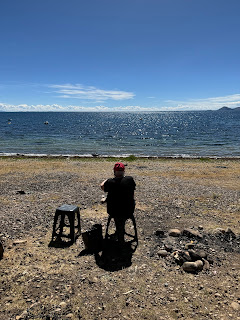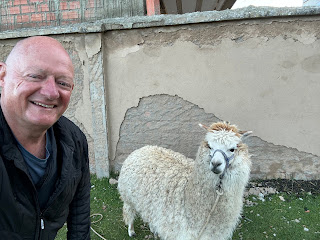The previous crew had spent nine hours crossing from Bolivia into Peru at the notorious Kasani Border Post, so we were prepared for anything. We are about to spend 16 days in Peru and wanted it to start well with the best possible documentation, especially for our bikes. So we arose early and reached the post about 30 minutes before it opened and the crowds descended. The previous Compass Expedition had taken nine hours to make this crossing.
As it happens, the buildings on the Peruvian side were burnt down by rioters a few years ago protesting about China's involvment in Peru. So now everything is done from rented shops and a caravan!
A key part of travelling by motorcycle is that you have to get yourself and passport through both immigration and customs on each side of the border AND get the bike approved and logged out of the old country and into the new one. It is like applying for a visa, using your bike registration as the "passport". While I have my original registration, I have been using a photocopy todate and it is now getting very dog-eared.
One of my complications is that my registration is all numbers (91518) and this "does not compute" with many of the systems each country uses. At the top of my plate are the letters "ACT" so I managed to get into one by using the registration number ACT91518! They checked the "placa" the actual plate and approved it! In this case, we had to scan a Q Code and then fill in an online form with all our bike details (and my mothers maiden name - no idea what this is for) - a real challenge as the form is all in Spanish! So we look for the logical things - name, country, birthday, address, nationality, rego, VIN and engine numbers etc and complete it. We used the WIFI from the official customs office to do this and they kindly gave us the log-in and password. Overall we were done in two hours and very pleased.
We were also warned that the road to Puno was terrible as they are doing a full refit on it. It was worse the terrible, with new bridges and gravel diversions quite regularly, plus one section of about 5km that was being re-surfaced and required about a 10 km diversion on particuarly gnarly gravel roads, full of rocks, potholes and billowing dust. We had had enough by the time we made Puno for a two course lunch which included tomato soup and rather nice local trout.
We then took pedal rickshaws to the port and a simple boat out to one of the floating islands, where we had been before. They suffered during covid and are a little sad now. Our island buildings looked genuine, but under the thatch was sawn timber, floor boards and a corrugated iron roof, all lit with 12 v LED bulbs powered by new solar panels, well hidden from the tourist view. Mmmm.
Our hotel is grand and old, being right on the main plaza, which makes for a great view, but right now, at 21:26 in the evening, there is a large oompah oompah band playing and marching outside. Welcome to Peru!

















































